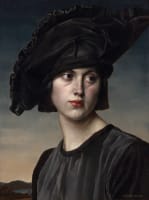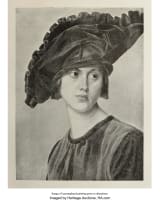

Gerald Leslie Brockhurst
(1890-1978) The War WidowProvenance
Probably Knoedler & Co., New York;
Charles E. Feinberg, Detroit, Michigan;
Private collection, Providence, Rhode Island, acquired from the estate of the above in 1992;
Heritage Auctions & Galleries, London, 9 June 2021, lot 69064;
Philip Mould & Company, acquired from the above.
Literature
Exhibitions
This enchanting portrait by Gerald Leslie Brockhurst coalesces traditional and modern artistic expression. Brockhurst was one of the most fashionable British portrait painters of the early twentieth century and boasted commissions from the period’s most glamorous sitters such as Margaret, Duchess of Argyll, Wallis Simpson, Duchess of Windsor, and Merle Oberon. In graceful contrapose, the present figure epitomises Brockhurst’s artistic dexterity through a work that is simultaneously timeless yet strikingly modern.
This painting was originally titled Andromache by the artist when it was painted circa 1923 [fig. 1]. This initial title references the Greek princess recorded in Homer's Iliad, who lost every male member of her family during the Trojan War. This portrait, painted in the aftermath of the First World War, consequently assumes a tragic relevance and poignancy. Brockhurst later reworked the painting and renamed it The War Widow. He lengthened the female figure’s fashionable bob, enlarged her right sleeve, and situated her within the atmospheric landscape, a trope...
This enchanting portrait by Gerald Leslie Brockhurst coalesces traditional and modern artistic expression. Brockhurst was one of the most fashionable British portrait painters of the early twentieth century and boasted commissions from the period’s most glamorous sitters such as Margaret, Duchess of Argyll, Wallis Simpson, Duchess of Windsor, and Merle Oberon. In graceful contrapose, the present figure epitomises Brockhurst’s artistic dexterity through a work that is simultaneously timeless yet strikingly modern.
This painting was originally titled Andromache by the artist when it was painted circa 1923 [fig. 1]. This initial title references the Greek princess recorded in Homer's Iliad, who lost every male member of her family during the Trojan War. This portrait, painted in the aftermath of the First World War, consequently assumes a tragic relevance and poignancy. Brockhurst later reworked the painting and renamed it The War Widow. He lengthened the female figure’s fashionable bob, enlarged her right sleeve, and situated her within the atmospheric landscape, a trope he would return to continually throughout his career.
The original appearance of Andromache (later, The War Widow) was reproduced in an article in The Studio, written by Alexander Joseph Finberg, an art historian and a founding member of the Walpole Society. The image documents Brockhurst’s original painting and provides an interesting insight into the inner workings of the artist’s working process. Within his article, Finberg heralded Brockhurst’s talent as a portraitist: ‘Mr. Brockhurst is one of the first to answer to the call of the century. What he has done cheers and delights me...’. Earlier in the article, he referenced Brockhurst’s proficiency in forging a new form of painterly expression:
Mr. Brockhurst’s work is to me one of the most cheering and hopeful signs in the art of the present. It responds to the needs of the time. It belongs emphatically to the twentieth century. It is not a mere echo of nineteenth-century formulas, but a new form of expression fashioned to meet the requirements of a new century.[1]
In 1940, this painting was included in a solo exhibition at the Carnegie Institute, Pennsylvania. At the time, The War Widow was in the collection of Charles E. Feinberg, an American collector who loaned two paintings to the exhibition; The War Widow and Caspar. The exhibition proved to be a success. The day before the exhibition closed, the Assistant Director of the Carnegie Institute wrote to Brockhurst; ‘The exhibition closes tomorrow, and we shall be sorry to see the pictures leave the building. There hasn’t been any exhibition in years that has attracted more visitors to the Carnegie Institute.’[2] Feinberg himself was so taken by The War Widow that he commissioned Brockhurst to paint his wife, Lenore.
Brockhurst’s fame continued to grow and his reputation as a portraitist of high society flourished throughout the twentieth century. His work is now held in a diverse range of collections including the Tate, the Scottish National Galleries, the Lady Lever Art Gallery, and the Royal Academy of Arts.
[1] Alex Finberg, (1923) ‘Gerald Brockhurst's Paintings and Drawings’ The Studio, Vol. 85, p. 246.
[2] O’Connor, J., Letter to Gerald Brockhurst 28 February 1940. ‘Carnegie Institute, Museum of Art records, 1883-1962, bulk 1885-1962’, Archives of American Art. Available at: https://www.aaa.si.edu/collect... p.34 (Accessed: 23 May 2022).







